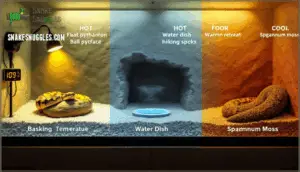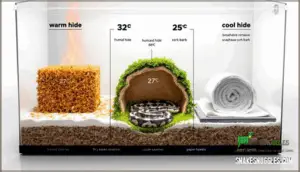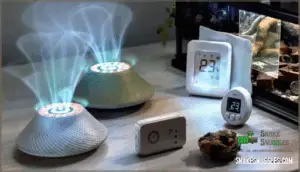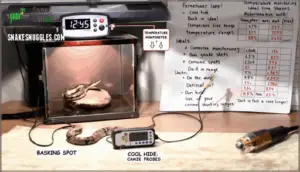This site is supported by our readers. We may earn a commission, at no cost to you, if you purchase through links.
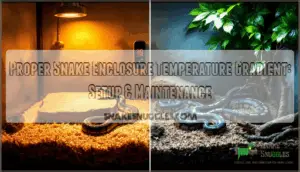
A proper snake enclosure temperature gradient isn’t just about hitting a specific number on a thermometer; it’s about creating a controlled range that mimics the thermal diversity your snake would experience in the wild. Getting this gradient right affects everything from digestion efficiency to immune response, yet many keepers struggle with hot spots that scorch and cold corners that chill.
Understanding how to set up, monitor, and maintain these critical temperature zones will transform your enclosure from a simple container into a thriving microhabitat.
Table Of Contents
Key Takeaways
- Snakes rely entirely on moving between warm zones (85–92°F) and cool zones (75–80°F) to regulate body temperature, digestion, immune function, and stress levels—without this gradient, they’ll stop eating or develop respiratory infections.
- Creating an effective thermal gradient requires strategic placement of heat sources covering one-third of the enclosure, positioning warm and cool hides at opposite ends, and using at least 4 inches of substrate to retain heat and support natural thermoregulation behaviors.
- Heat lamps, heat mats, and radiant panels each serve different purposes, but all require thermostat control to prevent dangerous temperature spikes—heat rocks should always be avoided due to their high risk of causing thermal burns.
- Accurate monitoring demands digital probe thermometers placed directly on basking surfaces and at the cool end, with regular calibration and seasonal adjustments to maintain stable gradients as room temperatures fluctuate throughout the year.
What is a Snake Enclosure Temperature Gradient?
A temperature gradient isn’t just a fancy term—it’s the foundation of your snake’s comfort and survival. Snakes can’t produce their own body heat, so they rely on moving between warmer and cooler zones to regulate everything from digestion to immune function.
Let’s break down what a gradient actually means, why it mirrors what happens in the wild, and how it directly impacts your snake’s health.
Definition and Purpose of Temperature Gradients
A thermal gradient is your snake’s temperature control system—a controlled range of temperatures spanning from warm to cool zones within the enclosure. You’re creating distinct areas where temperatures might range from 75°F on the cool side up to 90°F on the warm end.
This temperature regulation setup is critical because snakes are ectotherms, meaning they can’t generate their own body heat. Instead, they rely on behavioral thermoregulation, moving between zones to maintain metabolic efficiency, support immune response, and reduce stress.
Understanding the importance of thermal gradient design is key to replicating a snake’s natural habitat.
How Gradients Mimic Natural Habitats
In the wild, snakes navigate complex landscapes where sunlit rocks, shaded burrows, and vegetation layers create natural microclimates with temperature differences of up to 10°C within just a few meters. Your enclosure’s gradient design replicates this habitat complexity, allowing behavioral thermoregulation just as it occurs in nature.
Field studies show snakes maintain body temperatures between 22.5–30.9°C by shuttling between warm and cool zones—exactly what you’re replicating:
- Basking zones simulate solar exposure, mimicking rocks heated to 30–35°C
- Cool hides replicate shaded refuges near 24°C, preventing overheating
- Substrate layering mirrors ground temperature stratification found in natural soil profiles
This ecological consistency bolsters the thermal niche your snake evolved to exploit. To heighten the natural feel, consider adding loose substrate options to the enclosure.
Importance for Snake Health and Behavior
Getting temperature right determines whether your snake thrives or struggles. Proper thermal gradients support digestion efficiency—improper temperatures can slow digestion by 40%. Temperature regulation directly affects immune response, with cold conditions suppressing immunity by over 40%.
Proper thermal gradients support digestion and immunity—improper temperatures can slow digestion by 40% and suppress immune response by over 40%
Correct gradients reduce stress, boost activity levels by 45%, and improve metabolism while lowering energy expenditure.
When you maintain appropriate zones, your snake’s behavior, from feeding to shedding, follows natural patterns that promote long-term health.
Essential Temperature Ranges for Snakes
Getting the temperature right isn’t just about picking a number—your snake needs specific ranges for different areas of its enclosure to stay healthy.
Each zone has a purpose, from digestion to rest, and these requirements shift between day and night.
Let’s break down exactly what temperatures you should aim for in each part of your setup.
Warm Side Vs. Cool Side Temperatures
Your warm side should sit between 85°F and 92°F, while the cool side ranges from 75°F to 80°F. This thermal gradient lets your snake practice thermoregulation by moving between zones—basking in the warm hide for digestion efficiency or retreating to the cool hide to prevent thermal stress.
The gradient importance can’t be overstated: proper temperature regulation encourages basking behavior and keeps species needs met.
Recommended Nighttime and Daytime Ranges
During the day, you’ll want to maintain ideal gradients that support active metabolism and digestion. Nighttime temperature drops replicate natural cooling cycles, which help regulate your snake’s circadian rhythm and overall health.
- Daytime temperature: Keep ambient air between 80–85°F with basking spots at 88–92°F
- Nighttime temperature: Allow safe drops to 70–78°F for most species
- Ball python temperature requirements: Maintain 80–85°F ambient, with warmer basking zones at 90–92°F
- Species variations: Corn snakes tolerate cooler ranges (75–85°F daytime, 70°F nighttime)
- Seasonal adjustments: Recalibrate heating as room temperatures shift
Monitoring methods using dual-probe thermometers help you maintain the ideal temperature range. Health implications arise when gradients exceed ±3°F variation, affecting feeding and shedding cycles.
Species-Specific Requirements (e.g., Ball Pythons, Corn Snakes)
Each species has distinct thermal gradient needs. Ball pythons require warm sides at 85–88°F and basking spots at 88–92°F, while corn snakes thrive in cooler ranges of 75–85°F. Understanding these species-specific health correlations aids in proper snake enclosure temperature control and promotes reptile thermoregulation.
| Species | Warm Side | Cool Side | Basking Temperature Range |
|---|---|---|---|
| Ball pythons | 85–88°F (29–31°C) | 75–80°F (24–27°C) | 88–92°F (31–33°C) |
| Corn snakes | 85–90°F (29–32°C) | 75–85°F (24–29°C) | 85–88°F (29–31°C) |
Ball python temperatures run warmer than corn snake heating requirements, reflecting their African versus North American origins.
Setting Up a Proper Thermal Gradient
Creating the right thermal gradient isn’t about guessing—it’s about understanding how your snake uses different temperature zones throughout the day. You’ll need to position heat sources, hides, and substrate in a way that gives your snake real options to regulate its body temperature.
Let’s break down the three key elements that make an effective gradient work.
Enclosure Layout for Effective Gradients
You can’t just toss a heat lamp in the middle and hope for the best—your enclosure layout determines how well the thermal gradient actually works. Position your heat source at one end to cover roughly one-third of the space, creating a clear warm-to-cool progression that lets your snake choose temperature zones.
Add basking platforms under the lamp for focused warmth, use substrate depth of at least 5 cm to trap residual heat, and place decor or vertical barriers to create subtle vertical zones that improve temperature regulation throughout the enclosure.
Choosing Warm, Cool, and Humid Hide Locations
Think of your hides like checkpoints along a thermal highway—your snake won’t use them if they’re not strategically positioned. Placement decisions directly impact behavioral tracking patterns, microclimate stability, and your snake’s ability to thermoregulate effectively.
- Warm hide: Position directly over the hot end where the heat source maintains 31–33°C, using insulated hide material to stabilize thermal zones
- Cool hide: Place at the cool end opposite the warm side, keeping temperatures around 24–27°C with breathable construction for uniform humidity
- Humid hide: Set between warm and cool zones at 26–28°C to maintain 75–90% internal moisture for best shedding
- Spatial arrangement: Space hides evenly across the temperature gradient to support natural movement patterns and reduce stress-related behaviors by 35–40%
Substrate Depth and Its Role in Heat Retention
Your substrate depth acts like a thermal sponge—thicker layers hold warmth longer and create stable heat zones your snake needs for proper thermoregulation. You’ll want at least 4 inches of moisture-retentive substrate like coconut husk to support both heat retention and burrowing behavior near the warm hide.
Deeper substrate slows temperature drop-off across your gradient while improving ventilation needs, though substrate heat conductivity varies by material type.
Best Heating Methods and Equipment
Once you’ve established your thermal gradient, you’ll need the right heating equipment to maintain it safely and effectively.
Several heating options are available, each with specific strengths and limitations you should understand before making a choice.
Let’s break down the most reliable methods and the safety considerations that come with them.
Heat Lamps, Mats, and Radiant Panels
Choosing the right heat source is like picking the engine for your car—each option has strengths. Heat lamps produce focused hotspots up to 100°F, making them ideal for basking zones, but they consume more energy (around 90 watts). Heat mats offer belly warmth at 88–92°F with excellent mat efficiency at just 8–24 watts, though they barely affect ambient air.
Radiant heat panels excel in gradient stability and panel lifespan (over 25,000 hours), distributing heat evenly while retaining humidity better than lamps. For cost comparison, panels use 30% less energy than ceramic emitters.
Always pair your chosen device with a thermostat to prevent dangerous temperature spikes and maintain proper lamp safety.
Safe Use of Thermostats and Controllers
Any heat source without thermostat control can spike beyond 140°F—dangerous for your snake and your home. Electrical safety starts with probe placement: position the sensor directly under your heat lamp or mat where your snake basks.
Thermostat calibration every six months keeps accuracy within ±1°F, while dual thermostats add a backup layer if one fails. Remote monitoring systems alert you to temperature swings instantly, letting you respond before problems develop.
Why to Avoid Heat Rocks and Unsafe Devices
While thermostats protect you from catastrophic spikes, some heating devices carry built-in dangers no controller can fix. Heat rocks and hot rocks rank among the most dangerous options, causing thermal burns in roughly 30% of reptile injury cases seen by exotic vets. Their inconsistent heating creates spots exceeding 140°F while adjacent areas stay cool, and internal thermostats fail frequently—22% of enclosure accidents trace back to direct-contact heaters.
Your snake’s reduced heat sensitivity means tissue damage occurs before behavioral avoidance kicks in. Safer alternatives like overhead lamps and externally-placed heat mats with thermostats cut burn injuries by 40%.
Selecting The Right Wattage and Placement
Once you’ve ruled out unsafe devices, matching heat lamp wattage to your enclosure size becomes the next priority. A 20-gallon tank generally needs only 40 watts, while a 75-gallon setup may demand 80–100 watts for stable temperature gradients.
Follow these species examples for better heat distribution:
- Corn snakes thrive with 15–40-watt heat lamps in smaller setups
- Ball pythons require 80–100 watts for proper heating in 40–75-gallon enclosures
- Boa constrictors often need dual sources totaling 100–150 watts
Mount your heating device 8–12 inches above the basking surface and always use a thermostat. Proper thermostat calibration prevents overheating, while enclosure material like PVC retains 30% more warmth than glass, reducing wattage calculation needs.
Monitoring and Maintaining Temperatures
Setting up the right equipment is just the beginning—keeping your snake safe means knowing exactly what’s happening inside the enclosure at all times.
You’ll need reliable tools to track temperatures, smart placement strategies to catch problem areas, and a plan to adjust when conditions shift.
Let’s look at the essentials for monitoring and maintaining a stable thermal gradient.
Accurate Temperature Measurement Tools
You can’t manage what you can’t measure—that’s where precise monitoring comes in. Digital probe thermometers deliver digital accuracy within ±0.5°C, making them ideal for measuring enclosure temperature. Infrared thermometers let you check basking spots instantly without disturbing your snake.
Smart monitoring devices like the Tempcube offer remote temperature tracking with alerts when conditions drift. Pair these tools with proper thermostat calibration and regular maintenance practices to guarantee your temperature monitoring in snake cages stays reliable long-term.
Placement of Thermometers and Probes
Proper probe placement makes the difference between guessing and knowing. Position your thermostat probe directly on the substrate surface in the basking zone, ensuring firm probe contact with the enclosure floor—this boosts accuracy by up to 30%. For arboreal setups, place probes at canopy height near elevated basking surfaces.
Add a separate thermometer at the cool end to verify your temperature gradient stays within a 5–8°C difference. Secure probes with zip ties to prevent displacement, especially with burrowing species.
Regular calibration practices and safety considerations protect against overheating risks while maintaining enclosure temperature stability for effective temperature monitoring in snake cages.
Adjusting for Seasonal and Room Variations
When winter drops your room temperature by 10–15°F, you’ll need to recalibrate your thermostat and possibly upgrade to higher-wattage heating equipment. Ambient temperature directly influences your enclosure’s thermal gradient—basements stay stable within 4°F year-round, while rooms with large windows fluctuate 5–8°F daily.
Monitor both your warm and cool end temperatures with digital thermometers, adjusting heating output seasonally to maintain that critical 86–90°F basking zone without overshooting 95°F during summer months.
Preventing Overheating and Cold Spots
If you overlook ventilation strategies and insulation methods, you’re inviting trouble—overheating can push temperatures past 95°F and trigger stress within hours. Proper thermostat calibration paired with backup systems ensures your enclosure maintains a stable temperature gradient even when seasonal adjustments throw off your hot end or cool end.
- Check your thermostat daily—faulty readings cause 85% of overheating incidents
- Install cross-ventilation panels to drop peak temps by 25% during summer
- Position probes at your snake’s resting level for accuracy within ±0.5°C
Frequently Asked Questions (FAQs)
How does humidity affect temperature gradient accuracy?
What you measure isn’t always what you get" — humidity quietly skews your temperature readings and thermal gradient accuracy in reptile care. Higher humidity reduces convective transfer efficiency and affects sensor calibration, causing measurement errors up to 5%.
Your enclosure’s thermostat may register one temperature while your snake experiences a different perceived temperature, especially when evaporative cooling slows in humid conditions.
Can multiple snakes share one temperature gradient?
Housing multiple snakes in one enclosure creates thermal competition, preventing proper thermoregulation. Studies show snakes in shared spaces experience body temperature drops of 2-4°C and spend 30% more time outside ideal thermal zones, causing stress indicators and health implications that compromise species-specific temperature needs.
What substrate materials retain heat most effectively?
Coconut fiber and sphagnum moss retain heat best due to low thermal conductivity (039-065 W/mK) and high specific heat capacity.
Moisture retention greatly boosts their effectiveness—wet substrate density increases heat storage capacity.
Proper substrate selection with balanced moisture levels maintains enclosure temperature stability and creates an ideal enclosure environment.
How often should heating equipment be replaced?
Think of heating equipment as having a shelf life—heat lamps burn out in 4-6 months, mats degrade within 1-3 years, and radiant panels last over a decade.
Watch for inconsistent temperatures, strange odors, or thermostat malfunctions as failure indicators requiring immediate replacement for safe snake heating practices.
Do glass vs. plastic enclosures affect gradients?
Yes, enclosure material directly impacts temperature gradient stability and heating efficiency. Glass has higher thermal conductivity (around 0 W/m·K), losing heat faster than plastic enclosures. Plastic materials like PVC offer better insulation (11-20 W/m·K), maintaining gradients with less energy.
Your thermostat adjustments will differ between materials—glass needs more frequent heating, while plastic retains warmth longer.
Conclusion
Think of your enclosure like a well-tuned dial radio—precise positioning matters. Your snake needs that proper snake enclosure temperature gradient to thrive, shifting between thermal zones exactly as it would under an open sky or forest canopy.
Every adjustment you make—thermometer placement, thermostat calibration, substrate depth—directly impacts your snake’s ability to digest, heal, and simply exist comfortably. Get the gradient right, and you won’t just keep a snake; you’ll cultivate a resilient, healthy animal that behaves naturally and thrives for years.
- https://www.frontiersin.org/journals/amphibian-and-reptile-science/articles/10.3389/famrs.2024.1522805/full
- https://www.nature.com/articles/s41598-024-69378-4
- https://www.hvreptilerescue.org/resources/care-guides/ball-python-care-guide
- https://reptifiles.com/heterodon-hognose-snake-care/hognose-temperatures-humidity-lighting/
- https://www.facebook.com/groups/everythingballpythons/posts/1710731929568659/

